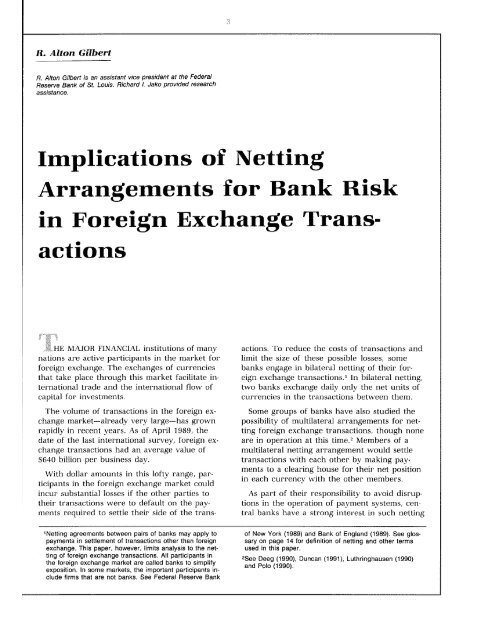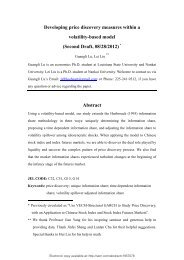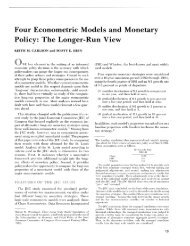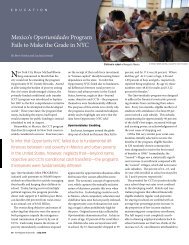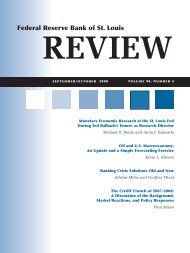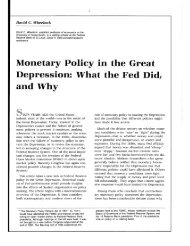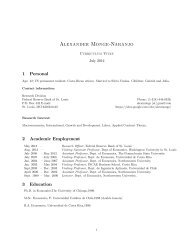Implications of Netting Arrangement for Bank Risk in Foreign ...
Implications of Netting Arrangement for Bank Risk in Foreign ...
Implications of Netting Arrangement for Bank Risk in Foreign ...
You also want an ePaper? Increase the reach of your titles
YUMPU automatically turns print PDFs into web optimized ePapers that Google loves.
R. Alton Gilbert<br />
R. Alton Gilbert is an assistant vice president at the Federal<br />
Reserve <strong>Bank</strong> <strong>of</strong> St. Louis. Richard I. Jako provided research<br />
assistance.<br />
<strong>Implications</strong> <strong>of</strong> <strong>Nett<strong>in</strong>g</strong><br />
<strong>Arrangement</strong>s <strong>for</strong> <strong>Bank</strong> <strong>Risk</strong><br />
<strong>in</strong> <strong>Foreign</strong> Exchange Transactions<br />
tHE MAJOR FINANCIAL <strong>in</strong>stitutions <strong>of</strong> many<br />
nations are active participants <strong>in</strong> the market <strong>for</strong><br />
<strong>for</strong>eign exchange. The exchanges <strong>of</strong> currencies<br />
that take place through this market facilitate <strong>in</strong>ternational<br />
trade and the <strong>in</strong>ternational flow <strong>of</strong><br />
capital <strong>for</strong> <strong>in</strong>vestments.<br />
The volume <strong>of</strong> transactions <strong>in</strong> the <strong>for</strong>eign exchange<br />
market—already very large—has grown<br />
rapidly <strong>in</strong> recent years. As <strong>of</strong> April 1989, the<br />
date <strong>of</strong> the last <strong>in</strong>ternational survey, <strong>for</strong>eign exchange<br />
transactions had an average value <strong>of</strong><br />
$640 billion per bus<strong>in</strong>ess day.<br />
1 <strong>Nett<strong>in</strong>g</strong> agreements between pairs <strong>of</strong> banks may apply to<br />
payments <strong>in</strong> settlement <strong>of</strong> transactions other than <strong>for</strong>eign<br />
exchange. This paper, however, limits analysis to the nett<strong>in</strong>g<br />
<strong>of</strong> <strong>for</strong>eign exchange transactions. All participants <strong>in</strong><br />
the <strong>for</strong>eign exchange market are called banks to simplify<br />
exposition. In some markets, the important participants <strong>in</strong>clude<br />
firms that are not banks. See Federal Reserve <strong>Bank</strong><br />
With dollar amounts <strong>in</strong> this l<strong>of</strong>ty range, participants<br />
<strong>in</strong> the <strong>for</strong>eign exchange market could<br />
<strong>in</strong>cur substantial losses if the other parties to<br />
their transactions ~s’ere to default on the payments<br />
required to settle their side <strong>of</strong> the transactions.<br />
To reduce the costs <strong>of</strong> transactions and<br />
limit the size <strong>of</strong> these possible losses, some<br />
banks engage <strong>in</strong> bilateral nett<strong>in</strong>g <strong>of</strong> their <strong>for</strong>eign<br />
exchange transactions.’ In bilateral nett<strong>in</strong>g,<br />
two banks exchange daily only the net units <strong>of</strong><br />
currencies <strong>in</strong> the transactions between them.<br />
Some groups <strong>of</strong> banks have also studied the<br />
possibility <strong>of</strong> multilateral arrangements <strong>for</strong> nett<strong>in</strong>g<br />
<strong>for</strong>eign exchange transactions, though none<br />
are <strong>in</strong> operation at this time.2 Members <strong>of</strong> a<br />
multilateral nett<strong>in</strong>g arrangement would settle<br />
transactions with each other by mak<strong>in</strong>g payments<br />
to a clear<strong>in</strong>g house <strong>for</strong> their net position<br />
<strong>in</strong> each currency with the other members.<br />
As part <strong>of</strong> their responsibility to avoid disruptions<br />
<strong>in</strong> the operation <strong>of</strong> payment systems, central<br />
banks have a strong <strong>in</strong>terest <strong>in</strong> such nett<strong>in</strong>g<br />
<strong>of</strong> New York (1989) and <strong>Bank</strong> <strong>of</strong> England (1989). See glossaw<br />
on page 14 <strong>for</strong> def<strong>in</strong>ition <strong>of</strong> nett<strong>in</strong>g and other terms<br />
used <strong>in</strong> this paper.<br />
2 See Deeg (1990), Duncan (1991), Luthr<strong>in</strong>ghausen (1990)<br />
and Polo (1990).
Table I<br />
M<strong>in</strong>imum Standards <strong>for</strong> the Design and Operation <strong>of</strong> Cross-<br />
Border and Multi-Currency <strong>Nett<strong>in</strong>g</strong> and Settlement Schemes<br />
I. <strong>Nett<strong>in</strong>g</strong> schemes should have a well-founded legal basis under all relevant jurisdictions.<br />
II<br />
Ill<br />
IV<br />
<strong>Nett<strong>in</strong>g</strong> scheme participants should have a clear understand<strong>in</strong>g <strong>of</strong> the impact <strong>of</strong> the particular<br />
scheme on each <strong>of</strong> the f<strong>in</strong>ancial risks affected by the nett<strong>in</strong>g process<br />
Multilateral nett<strong>in</strong>g systems should have clearly def<strong>in</strong>ed procedures <strong>for</strong> the management <strong>of</strong> credit<br />
risks and liquidity risks which specify the respective responsibilities <strong>of</strong> the nett<strong>in</strong>g provider and<br />
th participants. These procedures should also ensure that all parties have both the <strong>in</strong>centives<br />
and the capabilities to manage and conta<strong>in</strong> each <strong>of</strong> the risks they bear and that limits are placed<br />
on the maximum level <strong>of</strong> credit exposure that can be produced by each participant<br />
Multilateral nett<strong>in</strong>g systems should at a m<strong>in</strong>imum be capable <strong>of</strong> ensur<strong>in</strong>g the timely completion<br />
<strong>of</strong> daily settlements <strong>in</strong> the event <strong>of</strong> an <strong>in</strong>ability to settle by the participant with the largest s<strong>in</strong>gle<br />
net-debit position<br />
V. Multilateral nett<strong>in</strong>g systems should have objective and publicly disclosed criteria <strong>for</strong> admission<br />
which permit fair and open access<br />
VI<br />
All nett<strong>in</strong>g chemes should ensure the operational reliability <strong>of</strong>technical systems and the availa<br />
bility <strong>of</strong> back up facilities capable <strong>of</strong> complet<strong>in</strong>g daily process<strong>in</strong>g requirements<br />
SOURCE. <strong>Bank</strong> <strong>for</strong> International Settlements (1990c)<br />
art angements.” S<strong>in</strong>ce <strong>for</strong>eign exchange transac t<strong>in</strong>g ai iangements foi h<strong>in</strong>kers n ho ma~de~elop<br />
tions <strong>of</strong>ten mx olve parties headquartered <strong>in</strong> them (see table 1).’<br />
different countries, a default by one participant ,, - -<br />
- . - - I his paper illustiates the risk <strong>in</strong> settl<strong>in</strong>g <strong>for</strong>ts<br />
likely to affect those <strong>in</strong> other countries. <strong>Bank</strong>s - - . - -<br />
eign exchange transactions and the risk implicaadversely<br />
affected by such defaults typically - . - -<br />
- - - - . -<br />
would turn to then’ central banks <strong>for</strong> assistance<br />
tions <strong>of</strong> nett<strong>in</strong>g, us<strong>in</strong>g a hypothetical example <strong>of</strong><br />
. - -<br />
- - - - - -<br />
<strong>in</strong> cop<strong>in</strong>g with liquidity problems.<br />
transactions among three banks. 1 his exercise<br />
. . - - -<br />
illustrates how nett<strong>in</strong>g may reduce risk, ii net-<br />
In recent years, promoters <strong>of</strong> <strong>in</strong>terbank net- t<strong>in</strong>g arrangements con<strong>for</strong>m to the guidel<strong>in</strong>es <strong>in</strong><br />
t<strong>in</strong>g arrangements have requested the views <strong>of</strong> the Lamfalussv Report. 5<br />
central banks <strong>in</strong>dividually on projects that appeared<br />
to have implications <strong>for</strong> a number <strong>of</strong> F ‘U :t it K FT UGH Ft Ut FlU K UK —<br />
countries. ‘The central banks <strong>of</strong> 10 major <strong>in</strong>dus- - -<br />
trialized countries recently issued a jo<strong>in</strong>t statement,<br />
through the <strong>Bank</strong> <strong>for</strong> International Set-<br />
A <strong>for</strong>eign exchange transaction is an agreetlements,<br />
about the nett<strong>in</strong>g <strong>of</strong> <strong>for</strong>eign exchange ment by two parties (generally large banks) to<br />
transactions, This is commonly called the “La<strong>in</strong>- exchange currencies on a given date, called the<br />
falussv Report,’’ named after the committee value date <strong>of</strong> the transaction. ‘I’he most common<br />
chairman who drafted the report. The commit- type <strong>of</strong> transaction between participants <strong>in</strong> the<br />
tee expressed concern about the risks <strong>in</strong>volved <strong>for</strong>eign exchange market, a spot transaction, is<br />
<strong>in</strong> settl<strong>in</strong>g <strong>for</strong>eign exchange transactions and an agreement between two parties to exchange<br />
discussed the potential benefits and drawbacks units <strong>of</strong> currencies two bus<strong>in</strong>ess days from the<br />
<strong>of</strong> nett<strong>in</strong>g arrangements. The central bankers date the transaction is negotiated. A transaction<br />
listed m<strong>in</strong>imum standards <strong>for</strong> the design <strong>of</strong> net- with a value date more than two days after the<br />
3 See Summers (1991) <strong>for</strong> a discussion <strong>of</strong> the role <strong>of</strong> central <strong>of</strong> nett<strong>in</strong>g. See Juncker, Summers and Young (1991) <strong>for</strong> a<br />
banks <strong>in</strong> the operation <strong>of</strong> payment systems.<br />
general discussion <strong>of</strong> the issues raised by nett<strong>in</strong>g ar-<br />
4 bank <strong>for</strong> International Settlements (1990c). rangements.<br />
5 Cody (1990) also provides an <strong>in</strong>troduction to the risk <strong>in</strong><br />
settl<strong>in</strong>g <strong>for</strong>eign exchange transactions and the implications
date <strong>of</strong> negotiation is called a <strong>for</strong>ward transac<br />
tion. Some <strong>for</strong>ward transactions have value<br />
-______________________________________________<br />
dates more than a year <strong>in</strong>to the future, but Table 2<br />
most call <strong>for</strong> settlement with<strong>in</strong> a month. Several <strong>Foreign</strong> Exchange Market Activity <strong>in</strong><br />
other types <strong>of</strong> transactions, <strong>in</strong>clud<strong>in</strong>g futures April 1989 (billions <strong>of</strong> U.S. dollars) t<br />
contracts, options and swaps, have been developed<br />
to more effectively limit the effects <strong>of</strong> Countries and items Value <strong>of</strong> transactions per day<br />
changes <strong>in</strong> exchange rates on the wealth <strong>of</strong> United K<strong>in</strong>gdom $ 1872<br />
banks and their customers.” united States 1292<br />
Large commercial banks are the major par-<br />
Japan 115<br />
Switzerland 3 [555 I 57<br />
ticipants <strong>in</strong> the <strong>for</strong>eign exchange market. The S<strong>in</strong>gapor 55<br />
latest <strong>in</strong>ternational survey <strong>of</strong> <strong>for</strong>eign exchange Hong Kong 49<br />
activity, <strong>in</strong> April 1989, <strong>in</strong>dicates that the three Australia 30<br />
France 195%) 26<br />
most active centers are London, New York and Canada 15<br />
Tokyo (table 2). The value <strong>of</strong> <strong>for</strong>eign exchange Netherlands 13<br />
transactions has been grow<strong>in</strong>g faster than <strong>in</strong>ter- Denmark [90°/il 13<br />
national trade <strong>in</strong> goods and services (table 3). Sweden 3<br />
Such growth reflects more than the growth <strong>of</strong> Belgium [90°/i] 10<br />
- Italy l75°/°l 10<br />
<strong>in</strong>ternational trade; it also reflects <strong>in</strong>ternational Other countries 4 22<br />
capital flows and transactions by banks and<br />
their customers to manage exchange rate risk. otat 744<br />
Transactions <strong>in</strong> the <strong>for</strong>eign exchange market Adjustment <strong>for</strong><br />
l<strong>in</strong>k the major f<strong>in</strong>ancial <strong>in</strong>stitutions <strong>of</strong> the world, double-count<strong>in</strong>g 204<br />
In the London market, <strong>for</strong> <strong>in</strong>stance, 80 percent<br />
<strong>of</strong> the value <strong>of</strong> <strong>for</strong>eign exchange transactions <strong>in</strong> Total repor ed net<br />
April 1989 was by firms ivith headquarters out- turnove 540<br />
side <strong>of</strong> England.~In the survey <strong>of</strong> <strong>for</strong>eign cx-<br />
Estimated gaps <strong>in</strong><br />
change market activity <strong>in</strong> New York, 40 percent report<strong>in</strong>g 100<br />
<strong>of</strong> the value <strong>of</strong> transactions was reported by<br />
- . Estimated global<br />
<strong>of</strong>fices <strong>of</strong> <strong>for</strong>eign banks.” 1 hus, one <strong>of</strong> the im-<br />
- ... . . . turnover $ 640<br />
portant ivays <strong>in</strong> which a major f<strong>in</strong>ancial <strong>in</strong>stitution<br />
can affect <strong>in</strong>stitutions <strong>in</strong> other countries is<br />
- . . Value <strong>of</strong> transactions <strong>in</strong> currencies other than U S dotby<br />
default<strong>in</strong>g on <strong>for</strong>eign exchange transactions.<br />
tar converted to dollars at prevail<strong>in</strong>g exchange rates<br />
The figures <strong>for</strong> <strong>in</strong>dividual countries <strong>in</strong>dicate turnover<br />
a
Table 3<br />
Growth <strong>of</strong><br />
Trade and<br />
<strong>Foreign</strong> Exchange Market Transactions, <strong>Foreign</strong><br />
International <strong>Bank</strong><strong>in</strong>g Activity<br />
Countries<br />
Value <strong>of</strong> <strong>for</strong>eign exchange<br />
transactions: percentage<br />
change between March 1986<br />
to April 1989 net turnover<br />
Exports and imports <strong>of</strong><br />
goods and services:<br />
percentage change<br />
from 1/1986 to 1/1989<br />
United K<strong>in</strong>gdom 108% 62%<br />
United States 120 44<br />
Japan 140 82<br />
Canada 58 44<br />
Total 116 56<br />
SOURCE<br />
<strong>Bank</strong> <strong>for</strong> International Settlements (1990a)<br />
ment system. For a bank pay<strong>in</strong>g <strong>in</strong> a currency<br />
other than that <strong>of</strong> its home country, payment<br />
generally is made by a correspondent headquartered<br />
<strong>in</strong> the <strong>for</strong>eign country. A correspondent is<br />
a bank that holds deposits amid provides services<br />
<strong>for</strong> other banks. The pay<strong>in</strong>g bank commonly<br />
sends a message over SWIFT, <strong>in</strong>struct<strong>in</strong>g its correspondent<br />
to make payment to the counterparty<br />
<strong>in</strong> the <strong>for</strong>eign exchange transaction.’<br />
Suppose, <strong>for</strong> <strong>in</strong>stance, that a bank headquartered<br />
<strong>in</strong> the United States must pay German<br />
marks to a counterparty to settle a <strong>for</strong>eign exchange<br />
transaction. The U.S. bank <strong>in</strong>structs its<br />
German correspondent to make payment to the<br />
counterparty (or the counterparty’s German correspondent).<br />
The German correspondent debits<br />
the account <strong>of</strong> the U.S. hank denom<strong>in</strong>ated <strong>in</strong><br />
marks and transfers the marks to the counterparty.<br />
Suppose a U.S. hank is obligated to pay<br />
dollars. It would send a message over CHIPS to<br />
make payment to the counterparty, either directly<br />
if it is a member <strong>of</strong> CHIPS, or through a<br />
correspondent <strong>in</strong> New York who is a member<br />
<strong>of</strong> GRIPS)°<br />
<strong>Bank</strong>s assume the risk that their counterparties<br />
will default on payments on their side <strong>of</strong><br />
<strong>for</strong>eign exchange transactions. Effects on counterparties<br />
<strong>of</strong> default on settlement obligations<br />
depend on the f<strong>in</strong>ancial condition <strong>of</strong> the bank<br />
that defaults. A solvent hank may default <strong>for</strong> a<br />
variety <strong>of</strong> reasons. Operat<strong>in</strong>g problems (<strong>for</strong> cxample,<br />
computer failure) may prevent them<br />
from execut<strong>in</strong>g their payment <strong>in</strong>structions. A<br />
solvent counterparty may not have funds <strong>in</strong> the<br />
proper currency on the value date, or- simply<br />
may <strong>for</strong>get to send payment oi-ders to settle<br />
some <strong>of</strong> their transactions.<br />
Defaults by solvent banks on settlement obligations<br />
may have systemic effects, prevent<strong>in</strong>g<br />
other banks from settl<strong>in</strong>g their obligations.<br />
These banks may turn to their central banks<br />
<strong>for</strong> short-term loans denom<strong>in</strong>ated <strong>in</strong> the curren-<br />
‘SWIFT (Society <strong>for</strong> Worldwide Interbank F<strong>in</strong>ancial<br />
Telecommunication) is an electronic system, located <strong>in</strong><br />
Brussels, Belgium, <strong>for</strong> send<strong>in</strong>g messages among the<br />
world’s major banks,<br />
“See <strong>Bank</strong> <strong>for</strong> International Settlement (1990b) <strong>for</strong> a<br />
description <strong>of</strong> payments systems <strong>in</strong> various countries.<br />
CHIPS (Clear<strong>in</strong>g House <strong>for</strong> lnterbank Payments System) is<br />
an electronic payments system operated by the New York<br />
Clear<strong>in</strong>g House Association- CHIPS participants (131 as <strong>of</strong><br />
the end <strong>of</strong> 1990) exchange payment messages dur<strong>in</strong>g<br />
each bus<strong>in</strong>ess day and settle <strong>for</strong> the net amounts at dayend<br />
with transfers <strong>of</strong> reserve balances at the Federal<br />
Reserve. See Federal Reserve <strong>Bank</strong> <strong>of</strong> New York (1991).<br />
A large share <strong>of</strong> CHIPS messages <strong>in</strong>volve payment <strong>for</strong> the<br />
dollar side <strong>of</strong> <strong>for</strong>eign exchange transactions. Given that<br />
most <strong>for</strong>eign exchange transactions <strong>in</strong>volve the US. dollar,<br />
CHIPS has a major role <strong>in</strong> the settlement <strong>of</strong> <strong>for</strong>eign exchange<br />
transactions. See Federai Reserve <strong>Bank</strong> <strong>of</strong> New<br />
York (1987),
Table 4<br />
Payments <strong>in</strong> Settlement <strong>of</strong> <strong>Foreign</strong> Exchange Transactions under Gross Settlement<br />
and Bilateral <strong>Nett<strong>in</strong>g</strong><br />
Gross settlement<br />
Bilateral nett<strong>in</strong>g<br />
Transaction Direction <strong>of</strong> Units <strong>of</strong> Direction <strong>of</strong> Units <strong>of</strong><br />
Counterparties number payment currencies - payment currencies<br />
<strong>Bank</strong> A and I <strong>Bank</strong> A to <strong>Bank</strong> B t too Bark A to <strong>Bank</strong> B 50<br />
<strong>Bank</strong> B Banic B to <strong>Bank</strong> A $175 <strong>Bank</strong> B to <strong>Bank</strong> A $90<br />
(Pro’:t o’ $10.00 <strong>for</strong> <strong>Bank</strong> A)<br />
tProlil <strong>of</strong> $750 <strong>for</strong> <strong>Bank</strong> Aj<br />
2 <strong>Bank</strong>Ato<strong>Bank</strong>B SB5<br />
<strong>Bank</strong> B to <strong>Bank</strong> A 1 50<br />
(Pr<strong>of</strong>it <strong>of</strong> —82 50 fo’ Band A~<br />
<strong>Bank</strong> A and I <strong>Bank</strong> A to <strong>Bank</strong> C 100 <strong>Bank</strong> A to <strong>Bank</strong> C $92.50<br />
Bark C <strong>Bank</strong> C to <strong>Bank</strong> A $170 <strong>Bank</strong> C to <strong>Bank</strong> A 50<br />
(Pr<strong>of</strong>it <strong>of</strong> $500 For <strong>Bank</strong> Ay tP~<strong>of</strong>it<strong>of</strong> —51000 <strong>for</strong> <strong>Bank</strong> A)<br />
2 <strong>Bank</strong> A to <strong>Bank</strong> C $262.50<br />
<strong>Bank</strong> C to <strong>Bank</strong> A 1 ‘50<br />
~Pro’iI<strong>of</strong> —$1500 For <strong>Bank</strong> A)<br />
<strong>Bank</strong> B ano 1 <strong>Bank</strong> B to <strong>Bank</strong> C 150 <strong>Bank</strong> B to <strong>Bank</strong> C 1100<br />
Ban~C <strong>Bank</strong> C to <strong>Bank</strong> B 5262 50 <strong>Bank</strong> C to <strong>Bank</strong> B $17750<br />
lPr<strong>of</strong>it <strong>of</strong> $15.00 fo- <strong>Bank</strong> B) lPr<strong>of</strong>it <strong>of</strong> $1250 t or <strong>Bank</strong> B)<br />
2 <strong>Bank</strong>Blo<strong>Bank</strong>C 58500<br />
<strong>Bank</strong> C to Bar.k B 1 50<br />
fP’<strong>of</strong>it <strong>of</strong> — $2.50 <strong>for</strong> <strong>Bank</strong> B)<br />
cies necessary to settle their obligations. Thus,<br />
central banks have a collective <strong>in</strong>terest <strong>in</strong> m<strong>in</strong>imiz<strong>in</strong>g<br />
the chances <strong>of</strong> such liquidity problems.<br />
Most liquidity problems am-c <strong>of</strong>ten only temporary.<br />
<strong>Bank</strong>ruptcy and liquidation <strong>of</strong> a participant<br />
<strong>in</strong> the <strong>for</strong>eign exchange market, however,<br />
pose a more serious threat to <strong>in</strong>dividual<br />
counterparties and create the potential <strong>for</strong> systemic<br />
disruptions <strong>in</strong> the payment system (default<br />
by one bank caus<strong>in</strong>g default by others). Under a<br />
general def<strong>in</strong>ition <strong>of</strong> bankruptcy, the value <strong>of</strong><br />
liabilities exceeds the value <strong>of</strong> assets. Some large<br />
bankm-upt banks have been reorganized with assistance<br />
<strong>of</strong> their home governments. ‘The reorganized<br />
banks cont<strong>in</strong>ue to operate as go<strong>in</strong>g concerns,<br />
mak<strong>in</strong>g payments <strong>in</strong> settlement <strong>of</strong> their<br />
obligations. Such reorganizations impose no losses<br />
on their counterparties.<br />
In other cases, however, bankrupt banks<br />
cease to operate as go<strong>in</strong>g concerns. The courts<br />
appo<strong>in</strong>t receivers to liquidate the bankrupt<br />
banks’ assets and make payments to their creditors.<br />
The receivers may impose losses on other<br />
banks that were counterparties to <strong>for</strong>eign exchange<br />
transactions. Such losses depend on the<br />
legal pr-<strong>in</strong>ciples followed by bankm’uptcy courts<br />
and the nature <strong>of</strong> nett<strong>in</strong>g agreements between<br />
counterpar ties -<br />
The effects <strong>of</strong> the liquidation <strong>of</strong> a participant<br />
<strong>in</strong> the <strong>for</strong>eign exchange market on its cOunter’-<br />
parties are illustrated below Legal assumptions<br />
are specified along the way as the example<br />
raises questions about the pr<strong>in</strong>ciples followed<br />
by bankruptcy courts. In each case <strong>in</strong> which a<br />
bank is assumed to go bankrupt, it is also assumed<br />
to be liquidated by a court-appo<strong>in</strong>ted<br />
receiver.<br />
The.E~rampIe<br />
Suppose three banks (A, B and C) engage <strong>in</strong><br />
fom’eign exchange transactions <strong>in</strong> two currencies:<br />
the U.S. dollar and the British pound. Each<br />
bank has <strong>for</strong>eign exchange transactions with the<br />
other two. ‘Table 4 lists the transactions between
the counterparties to be settled on the same<br />
value date. Each pair <strong>of</strong> banks has two transactions<br />
to settle. In one transaction, a hank pays<br />
dollars <strong>in</strong> exchange <strong>for</strong> pounds; <strong>in</strong> the other, a<br />
bank pays pounds <strong>in</strong> exchange <strong>for</strong> dollars.<br />
The exchange rate on the value date is $1.65<br />
per British pound. Transactions to he settled on<br />
the value date were negotiated a few days earlier-<br />
when the exchange rate was higher: some<br />
transactions were negotiated with an exchange<br />
rate <strong>of</strong> $1.70; others, with an exchange rate <strong>of</strong><br />
$1.75. Transactions are <strong>of</strong> vary<strong>in</strong>g size, creat<strong>in</strong>g<br />
imbalances <strong>in</strong> the flows <strong>of</strong> currencies between<br />
counterparties.<br />
The example is designed to be as simple as<br />
possible and yet illustrate the risk <strong>in</strong>volved <strong>in</strong><br />
nett<strong>in</strong>g arrangements. ‘rhere must he at least<br />
two transactions between a pair <strong>of</strong> banks if<br />
bilateral nett<strong>in</strong>g is to reduce the volume <strong>of</strong> payments<br />
and settlement risk. Three is the m<strong>in</strong>imum<br />
number <strong>of</strong> banks <strong>for</strong> multilatemal nett<strong>in</strong>g.<br />
ia,, It/i ~ ~ ~ ~<br />
the I%,.:n,nfler am.! t:i:nue: ttj<br />
‘Itans~<br />
Figure 1 illustrates how bilateral nett<strong>in</strong>g affects<br />
the flows <strong>of</strong> currencies between <strong>Bank</strong>s A<br />
and B <strong>in</strong> settl<strong>in</strong>g the transactions listed <strong>in</strong> table 4.<br />
Under gross settlement, banks make payments<br />
to each other to settle each transaction between<br />
them. To settle transaction number 1, <strong>Bank</strong> A<br />
pays £ 100 to <strong>Bank</strong> B, receiv<strong>in</strong>g $175 <strong>in</strong> turn.<br />
S<strong>in</strong>ce the exchange rate is $1.65 on the value<br />
date, this exchange <strong>of</strong> currencies yields a pr<strong>of</strong>it<br />
<strong>of</strong> $10 to <strong>Bank</strong> A. (<strong>Bank</strong> A receives $175, whereas<br />
the £ 100 paid by <strong>Bank</strong> A has a value <strong>of</strong> $165<br />
on the value date). <strong>Bank</strong> A pays $85 to <strong>Bank</strong> B<br />
<strong>in</strong> settlement <strong>of</strong> transaction number 2, receiv<strong>in</strong>g<br />
£ 50. This exchange yields a loss <strong>of</strong> S2.50 <strong>for</strong><br />
<strong>Bank</strong> A on the value date.<br />
<strong>Bank</strong>s A and B can economize on transactions<br />
by nett<strong>in</strong>g their payments flows. As illustrated<br />
<strong>in</strong> the bottom half <strong>of</strong> figure 1, <strong>Bank</strong> A could<br />
pay £ 50 to <strong>Bank</strong> B and receive $90 from <strong>Bank</strong><br />
B. Bilateral nett<strong>in</strong>g reduces the number <strong>of</strong> payments<br />
from four to two arid the value <strong>of</strong> payments,<br />
converted to dollars at the exchange rate<br />
<strong>of</strong> $1.65, from $507.50 to $172.50.<br />
!ts’k ui ~~.;E:I~’!!!.flf!j~’(fl’~‘-pfl L~r-<br />
C!! •anLe TC1:I!flsa(IIt( .~ rtflar.ri a<br />
i%thlIth.g .[tr’anee.!m!m<br />
To illustrate how nett<strong>in</strong>g arrangenients affect<br />
risk, one must first understand the risk that<br />
banks assume without a nett<strong>in</strong>g agreement.<br />
Legal ,%aeu t pLaa’ta .... This section specifies<br />
several assumptions about the legal pr<strong>in</strong>ciples<br />
that the bankruptcy court follows when banks<br />
settle their transactions without nett<strong>in</strong>g arrangements.<br />
While these pr<strong>in</strong>ciples are not applied <strong>in</strong><br />
all cases, they at-c common and they simplify<br />
the analysis.<br />
One assumption concerns the application <strong>of</strong> legal<br />
rights <strong>of</strong> set-<strong>of</strong>f permitted by the court. Under’<br />
the legal rights <strong>of</strong> set-<strong>of</strong>f, the counterparty<br />
<strong>of</strong> a failed bank may settle its obligations with<br />
the receiver by pay<strong>in</strong>g the net amount <strong>of</strong> the<br />
transactions between them. If on net the failed<br />
bank owes a solvent counterparty, the counterparty<br />
is a general creditor <strong>of</strong> the failed bank <strong>for</strong><br />
the net amount. Apply<strong>in</strong>g the rights <strong>of</strong> set-<strong>of</strong>f to<br />
the <strong>for</strong>eign exchange transactions between a<br />
pair <strong>of</strong> banks yields the same loss to the solvent<br />
countem’party as it would under bilateral nett<strong>in</strong>g.<br />
Apply<strong>in</strong>g the legal rights <strong>of</strong> set-<strong>of</strong>f, however, is<br />
uncerta<strong>in</strong> and varies among the courts <strong>of</strong> different<br />
countries.” In this paper, rights <strong>of</strong> set-<strong>of</strong>f<br />
are assumed not to apply <strong>in</strong> bankr’uptc~.Each<br />
transaction is treated separately, not l<strong>in</strong>ked to<br />
other transactions between the same par-ties.<br />
The court with jurisdiction <strong>in</strong> a bankruptcy<br />
case is assumed to appo<strong>in</strong>t a receiver. In mak<strong>in</strong>g<br />
payments to settle <strong>for</strong>eign exchange transactions<br />
or default<strong>in</strong>g on transactions, the receiver<br />
acts to maximize the return to all creditors <strong>of</strong><br />
the failed bank, without regard <strong>for</strong> the counterparties<br />
to <strong>for</strong>eign exchange transactions as a<br />
particular group <strong>of</strong> creditors.<br />
A f<strong>in</strong>al issue concerns the status <strong>of</strong> claimns<br />
aga<strong>in</strong>st a bankrupt bank that result from its<br />
default on <strong>for</strong>eign exchange transactions. Solvent<br />
counterparties are assumed to have the<br />
status <strong>of</strong> general creditor’s. In our example, losses<br />
are calculated under the assumption that<br />
general creditors receive noth<strong>in</strong>g. All proceeds<br />
from the liquidation <strong>of</strong> assets go to creditors<br />
with more senior claims.<br />
‘ 1 <strong>Bank</strong> <strong>for</strong> International Settlements (1989), pp. 13-14.
9<br />
Figure 1<br />
Flow <strong>of</strong> Currencies Between <strong>Bank</strong>s Under Gross Settlement and Bilateral <strong>Nett<strong>in</strong>g</strong><br />
Gross Settlement<br />
£ 100<br />
Transaction #1 Pr<strong>of</strong>it to <strong>Bank</strong> A:<br />
$10.00<br />
RRfl~<br />
___<br />
£ 50<br />
.<br />
Transaction #2<br />
585<br />
ULHL<br />
1I\<br />
Pr<strong>of</strong>it to <strong>Bank</strong> A:<br />
-$2.50<br />
Number <strong>of</strong> Payments: 4<br />
Dollar Value: $507.50<br />
Bilateral <strong>Nett<strong>in</strong>g</strong><br />
£50<br />
Pr<strong>of</strong>it to <strong>Bank</strong> A:<br />
~.50<br />
nnnH<br />
L!ULH<br />
~~~BANK<br />
B<br />
UUL:U<br />
______<br />
__-j<br />
$90<br />
Number <strong>of</strong> Payments: 2<br />
Dollar Value: $172.50
‘These legal assumptions yield the maximumn<br />
losses to counterparties. Thus, the losses calculated<br />
<strong>in</strong> particular cases can be viewed as the<br />
maximum, not necessarily the most likely, losses.<br />
pa~are Suppose <strong>Bank</strong>s A and B agree to settle<br />
theim’ tm-ansactions as illustrated <strong>in</strong> the top<br />
half <strong>of</strong> figure 1, the gross settlement method.<br />
Suppose also that <strong>Bank</strong> A goes hankmupt be<strong>for</strong>e<br />
the four payments are executed on the value<br />
date. The possible loss to <strong>Bank</strong> B depends on<br />
the tim<strong>in</strong>g <strong>of</strong> the bankruptcy <strong>of</strong> <strong>Bank</strong> A.<br />
In one situation, called jjre-settlement failure,<br />
<strong>Bank</strong> A goes bankrupt be<strong>for</strong>e the value date,<br />
and <strong>Bank</strong> B knows about this event by the<br />
open<strong>in</strong>g <strong>of</strong> bus<strong>in</strong>ess on the value date. In the<br />
other situation, called settlement failure, a bank<br />
makes payment on the value date <strong>for</strong> its side <strong>of</strong><br />
<strong>for</strong>eign exchange transactions but does not receive<br />
payment from a counterparty.<br />
One feature <strong>of</strong> the <strong>for</strong>eign exchange market<br />
that makes banks vulnerable to settlement failure<br />
is the difference <strong>in</strong> the time zones <strong>of</strong> central<br />
banks. The failure <strong>of</strong> the Herstatt <strong>Bank</strong> <strong>in</strong><br />
1974 illustrates the relationship between time<br />
zones and settlement failure. On June 26, 1974,<br />
German bank<strong>in</strong>g authorities closed Herstatt as<br />
<strong>of</strong> the close <strong>of</strong> bus<strong>in</strong>ess <strong>in</strong> Germany. Herstatt<br />
had received payment <strong>in</strong> marks dur<strong>in</strong>g German<br />
bank<strong>in</strong>g hours <strong>for</strong> its <strong>for</strong>eign exchange transactions<br />
with that value date. It was closed, however,<br />
be<strong>for</strong>e the time <strong>for</strong> mak<strong>in</strong>g payments <strong>in</strong><br />
dollars <strong>in</strong> New York. Counterparties <strong>of</strong> Herstatt<br />
were left without the dollars they expected, after<br />
pay<strong>in</strong>g marks to Flerstatt earlier <strong>in</strong> the day.’ 2<br />
Our example <strong>of</strong> settlement failure <strong>in</strong> this paper<br />
reflects the implications <strong>of</strong> differences <strong>in</strong> time<br />
zones. One bank is assumed to go bankrupt after<br />
the time <strong>for</strong> payments <strong>in</strong> pounds but be<strong>for</strong>e<br />
the time <strong>for</strong> mak<strong>in</strong>g payments <strong>in</strong> dollars.<br />
Pre-Settlement Failure — Suppose <strong>Bank</strong> A<br />
goes bankrupt be<strong>for</strong>e the value date. Without a<br />
nett<strong>in</strong>g agreement between <strong>Bank</strong>s A and B, the<br />
legal obligations <strong>of</strong> each hank are those specified<br />
<strong>in</strong> the <strong>in</strong>dividual transactions between them.<br />
With an exchange rate <strong>of</strong> $1.65 on the value<br />
date, transaction number I ispr<strong>of</strong>itable to <strong>Bank</strong><br />
A. The receiver <strong>of</strong> <strong>Bank</strong> A will pay £ 100 to<br />
<strong>Bank</strong> B to settle transaction number 1. <strong>Bank</strong> B is<br />
obligated to pay $175 to <strong>Bank</strong> A to settle this<br />
transaction. S<strong>in</strong>ce transaction number 2 is not<br />
pr<strong>of</strong>itable to <strong>Bank</strong> A on the value date, the receiver<br />
will default on transaction number 2.<br />
<strong>Bank</strong> B anticipated a pr<strong>of</strong>it <strong>of</strong> $2.50 on the value<br />
date from transaction numnber 2. Thus, the bankruptcy<br />
<strong>of</strong> <strong>Bank</strong> A imposes a loss <strong>of</strong> $2.50 on<br />
<strong>Bank</strong> B. ‘Table 5 shows the loss to each bank<br />
due to the bankruptcy <strong>of</strong> its counterparty be<strong>for</strong>e<br />
the value date, under both gross settlement<br />
and nett<strong>in</strong>g arrangements.<br />
Settlement Failure — Suppose <strong>Bank</strong> A goes<br />
bankrupt on the value date after payment <strong>in</strong><br />
pounds but be<strong>for</strong>e payment <strong>in</strong> dollars. <strong>Bank</strong> A<br />
defaults on its payment <strong>of</strong> $85 to <strong>Bank</strong> B on the<br />
value date. Under gross settlement <strong>of</strong> transactions,<br />
however, <strong>Bank</strong> B is obligated to pay the<br />
$175 to <strong>Bank</strong> A. <strong>Bank</strong> B becomes a general creditor<br />
<strong>of</strong> <strong>Bank</strong> A <strong>for</strong> $85. The maximum loss to<br />
<strong>Bank</strong> B, as table 6 <strong>in</strong>dicates, is $85.<br />
Settlement failure can create liquidity problems<br />
<strong>for</strong> the counterparties <strong>of</strong> a failed bank. Suppose<br />
<strong>Bank</strong> B pays the $175 to <strong>Bank</strong> A be<strong>for</strong>e discover<strong>in</strong>g<br />
that <strong>Bank</strong> A is bankrupt. ‘T’he cash balances<br />
<strong>of</strong> <strong>Bank</strong> B denom<strong>in</strong>ated <strong>in</strong> dollars will he<br />
$85 below the level it had projected <strong>for</strong> the<br />
value date. <strong>Bank</strong> B might request a discount<br />
w<strong>in</strong>dow loan from the Federal Reserve to cover<br />
the $85 shortfall <strong>in</strong> its m’eserve account.<br />
f•~~7a<br />
sa.Cfef!tLs<br />
If <strong>Bank</strong>s A and B engage <strong>in</strong> bilateral nett<strong>in</strong>g, the<br />
effects <strong>of</strong> the bankruptcy <strong>of</strong> <strong>Bank</strong> A on <strong>Bank</strong> B<br />
depend on whether pay<strong>in</strong>g the net amount discharges<br />
the obligations between counterparties.<br />
ta-eel ;%eetitfletiufls Under one type <strong>of</strong><br />
agreement called position nett<strong>in</strong>g, two banks<br />
agree to net their payments to reduce transactions<br />
costs, hut the agreement has no effect on<br />
their legal obligations. Under’ the legal assumptions<br />
<strong>in</strong> this paper, the position nett<strong>in</strong>g agreement<br />
would not prevent the receiver from<br />
mak<strong>in</strong>g payments <strong>in</strong> settlement <strong>of</strong> some transactions<br />
hut default<strong>in</strong>g on other’s with the same<br />
counterparty. The bankruptcy court would treat<br />
the payment obligation <strong>of</strong> <strong>Bank</strong>s A and B as<br />
though they had no nett<strong>in</strong>g agreement. The<br />
bankruptcy <strong>of</strong> one party has the same implica-<br />
‘ 2 Moore (1974).
Table 5<br />
<strong>Bank</strong> Losses from Pre-Settlement<br />
Failure<br />
-- Losses to<br />
Failure <strong>of</strong> - - <strong>Bank</strong> A <strong>Bank</strong> B <strong>Bank</strong> C<br />
<strong>Bank</strong> A<br />
Gross settlement $ 250 $15.00<br />
Bilateral nett<strong>in</strong>g 0.00 10.00<br />
Multilateral nett<strong>in</strong>g 0.00 250<br />
<strong>Bank</strong> B<br />
Gross settlement $10.00 250<br />
Bilateral nett<strong>in</strong>g 750 0.00<br />
Multilateral nett<strong>in</strong>g 0.00 000<br />
<strong>Bank</strong> C<br />
Gross settlement 500 15.00<br />
Bilateral nett<strong>in</strong>g OflO 12.50<br />
Multilateral nett<strong>in</strong>g 0.00 250<br />
Table 6<br />
<strong>Bank</strong> Losses from Settlement Failure<br />
Losses to<br />
Failure <strong>of</strong> <strong>Bank</strong> A <strong>Bank</strong> B <strong>Bank</strong> C<br />
<strong>Bank</strong> A<br />
Gross settlement $ 85.00 5262 50<br />
Bilateral nett<strong>in</strong>g 0.00 9250<br />
Multilateral nett<strong>in</strong>g 0.00 2.50<br />
<strong>Bank</strong> B<br />
Gross settlement $17500 85.00<br />
Bilateral nettng 90.00 0.00<br />
Multilateral nett<strong>in</strong>g 000 0.00<br />
<strong>Bank</strong> C<br />
Gross settlement 170 00 262.50<br />
Bilateral nett<strong>in</strong>g 0.00 177.50<br />
Multilateral nett<strong>in</strong>g 0.00 85.00<br />
tii}I)~, It)! liii’ ii)t<strong>in</strong>til liuit\ LIS 1 the~ ‘,t’ttletl<br />
1<br />
tiLiri~zu’ I iou” LIr,1u1U Ihi i1rn’,’, settle<strong>in</strong>ruil method.<br />
“<strong>Bank</strong> <strong>for</strong> International Settlements (1989), p. 13.<br />
“One firm that <strong>of</strong>fers legal advice and a oommunications<br />
network <strong>for</strong> bilateral nett<strong>in</strong>g by novation is FXNET. The<br />
nett<strong>in</strong>g oontract drafted by FXNET <strong>in</strong>cludes nett<strong>in</strong>g by novation<br />
and closeout. See Bartko (1990). For further reference<br />
to FXNET, see Scarlata (1992), this Review. Plans<br />
<strong>Nett<strong>in</strong>g</strong> agreements that reduce this exposure<br />
to loss mandate that banks discharge their obligations<br />
by pay<strong>in</strong>g the net amount <strong>of</strong> the transactions<br />
between them. The legal language <strong>for</strong><br />
such agreements is nett<strong>in</strong>g by novation. This<br />
paper assumes that bankruptcy courts recognize<br />
a contract <strong>for</strong> nett<strong>in</strong>g by novation as the only<br />
contract between counterparties <strong>for</strong> settlement<br />
<strong>of</strong> <strong>for</strong>eign exchange transactions.<br />
A provision <strong>of</strong> bilateral nett<strong>in</strong>g contracts that<br />
reduces risk is called closeout, which becomes<br />
effective when a receiver or liquidator is appo<strong>in</strong>ted<br />
after a bank declares bankruptcy.” A<br />
nett<strong>in</strong>g agreement <strong>in</strong>cludes a <strong>for</strong>mula that converts<br />
all outstand<strong>in</strong>g transactions between a<br />
pair <strong>of</strong> counterparties, <strong>for</strong> all value dates, <strong>in</strong>to<br />
one amount payable immediately. The closeout<br />
provision prohibits the receiver <strong>of</strong> a bankrupt<br />
bank from mak<strong>in</strong>g payments <strong>in</strong> settlement <strong>for</strong><br />
transactions with some value dates but default<strong>in</strong>g<br />
on transactions with other value dates.”<br />
<strong>Bank</strong>ruptcy courts are assumed to recognize<br />
closeout provisions as valid parts <strong>of</strong> nett<strong>in</strong>g arrangements.<br />
— As the bottom<br />
half <strong>of</strong> figure 1 illustrates, the one contract between<br />
<strong>Bank</strong>s A and B under nett<strong>in</strong>g by novation<br />
calls <strong>for</strong> <strong>Bank</strong> A to pay £ 50 and receive $90. At<br />
the exchange rate <strong>of</strong> $1.65 on the value date,<br />
this contract is pr<strong>of</strong>itable <strong>for</strong> <strong>Bank</strong> A. Thus, the<br />
receiver <strong>of</strong> <strong>Bank</strong> A would pay the £ 50 to <strong>Bank</strong><br />
B to settle the contract. The bankruptcy <strong>of</strong> <strong>Bank</strong><br />
A prior to the value date would impose no loss<br />
on <strong>Bank</strong> B, s<strong>in</strong>ce <strong>Bank</strong> B had anticipated honor<strong>in</strong>g<br />
its contract with <strong>Bank</strong> A be<strong>for</strong>e discover<strong>in</strong>g<br />
that <strong>Bank</strong> A was bankrupt. In each case <strong>of</strong> presettlement<br />
failure illustrated <strong>in</strong> table 5, the losses<br />
are smaller under bilateral nett<strong>in</strong>g by novation<br />
than under gross settlement.<br />
— The bankruptcy <strong>of</strong><br />
<strong>Bank</strong> A after payments <strong>in</strong> pounds but be<strong>for</strong>e<br />
payments <strong>in</strong> dollars imposes no loss on <strong>Bank</strong> B<br />
s<strong>in</strong>ce, under the nett<strong>in</strong>g agreement, <strong>Bank</strong> A had<br />
no obligation to pay dollars to <strong>Bank</strong> B. As table<br />
6 <strong>in</strong>dicates, <strong>in</strong> settlement failure, the loss to a<br />
bank from the bankruptcy <strong>of</strong> its counterparty is<br />
<strong>for</strong> multilateral nett<strong>in</strong>g <strong>in</strong>clude similar closeout provisions<br />
<strong>in</strong> contracts between <strong>in</strong>dividual members and the clear<strong>in</strong>g<br />
houses that would act as pay<strong>in</strong>g agents <strong>for</strong> the nett<strong>in</strong>g arrangements.<br />
See Duncan (1991). These closeout provisions<br />
limit the losses <strong>of</strong> solvent banks result<strong>in</strong>g from<br />
default by counterparties.
12<br />
smaller under bilateral nett<strong>in</strong>g by nox’ation than<br />
under’ gross settlement <strong>for</strong> each comb<strong>in</strong>ation <strong>of</strong><br />
failed hank amid counterparty.<br />
‘The assumptions <strong>in</strong> this paper concern<strong>in</strong>g the<br />
pr<strong>in</strong>ciples that bankruptcy courts follow yield<br />
the maximum reductions <strong>in</strong> losses from nett<strong>in</strong>g.<br />
These reductions <strong>in</strong> losses could he smaller under<br />
alternative assumptions.<br />
‘The Lamfalussv Report <strong>in</strong>dicates that hilatem-al<br />
nett<strong>in</strong>g could <strong>in</strong>crease risk <strong>in</strong> settl<strong>in</strong>g <strong>for</strong>eign exchange<br />
transactions if nett<strong>in</strong>g arrangements do<br />
not have a sound legal basis. If nett<strong>in</strong>g obscures<br />
the level <strong>of</strong> exposures, then nett<strong>in</strong>g arrangemerits<br />
have the lJotential to contribute to an <strong>in</strong>crease<br />
<strong>in</strong> sstemic risk.’’’’ The argument that<br />
bilateral nett<strong>in</strong>g may pose greater risks is based<br />
on assumptions about how banks that are active<br />
<strong>in</strong> the <strong>for</strong>eign exchange market set credit limits<br />
with counterparties. <strong>Bank</strong>s with bilateral nett<strong>in</strong>g<br />
agreements max’ set credit lirni ts with each other<br />
based on their net positions rather than the<br />
gross value <strong>of</strong> the underly<strong>in</strong>g transactions hetween<br />
them. If a bankruptcy court requires<br />
payments by a solvent countem-pam’tv based on<br />
the value <strong>of</strong> the underly<strong>in</strong>g transactions rather<br />
than the nett<strong>in</strong>g agreement, the exposure <strong>of</strong> the<br />
solvent counterpartv would he larger than cxpected.<br />
This po<strong>in</strong>t <strong>in</strong>dicates why the Lamfalussv<br />
Report emphasizes the legal basis <strong>for</strong> nett<strong>in</strong>g ari-angements<br />
(table 1).<br />
<strong>Bank</strong>s may be able to further reduce their<br />
transaction costs and their exposure to loss by<br />
engag<strong>in</strong>g <strong>in</strong> multilateral nettimig. No multilateral<br />
nett<strong>in</strong>g arrangements are <strong>in</strong> operation at this<br />
time. This section exam<strong>in</strong>es the implications <strong>of</strong> a<br />
multilateral nett<strong>in</strong>g arr’angement modeled after<br />
a draft <strong>of</strong> the plans <strong>of</strong> the ECHO NETTING system<br />
<strong>in</strong> London.”<br />
I .a~ ,rmi~Iona — In the contract <strong>for</strong><br />
multilateral nett<strong>in</strong>g, members <strong>of</strong> a nett<strong>in</strong>g at’-<br />
rangement establish a clear<strong>in</strong>g house, which<br />
receives and pays out currencies <strong>in</strong> settlement<br />
<strong>of</strong> <strong>for</strong>eign exchange transactions. The clear<strong>in</strong>g<br />
house is the counterparty <strong>for</strong> each tm’ansaction<br />
between members <strong>of</strong> the multilateral nett<strong>in</strong>g arrangement.<br />
Each member settles its legal obligations<br />
with the other’s by mak<strong>in</strong>g payments to<br />
the clear<strong>in</strong>g house. ‘The clear<strong>in</strong>g house assumes<br />
responsibility <strong>for</strong> pav<strong>in</strong>g all net amounts due to<br />
members, even if a member defaults on its payments<br />
to the clear<strong>in</strong>g house.<br />
‘l’he contract <strong>in</strong> a <strong>in</strong>ulti lateral nett<strong>in</strong>g arrangement<br />
is assumed to <strong>in</strong>clude a closeout provision.<br />
If a member <strong>of</strong> the clear<strong>in</strong>g house goes bankrupt,<br />
its receiver has only one decision to make<br />
about the <strong>for</strong>eign exchange transactions that the<br />
failed bank negotiated with other’ members:<br />
make the pa~mnentsto settle the one contract<br />
with the clear<strong>in</strong>g house or default.<br />
a ~.:I ~.~:‘~•a a. d ~‘ . a a ~:, .~ a —<br />
F’igum-e 2 presents the payments between rnemhers<br />
<strong>of</strong> the nett<strong>in</strong>g arrangement and the clear<strong>in</strong>g<br />
house, derived from payments that would<br />
he made under bilateral nett<strong>in</strong>g <strong>in</strong> table 4. The<br />
calculation <strong>of</strong> the numbers <strong>in</strong> figure 2 is illustrated<br />
<strong>for</strong> <strong>Bank</strong> A. Under bilateral nett<strong>in</strong>g, <strong>Bank</strong><br />
A pays the other banks £ so (<strong>Bank</strong> B) and $92.50<br />
(<strong>Bank</strong> C) and receives $90 (<strong>Bank</strong> B) and £ 50<br />
(<strong>Bank</strong> C). Under mnultilatemal nett<strong>in</strong>g, there<strong>for</strong>e,<br />
<strong>Bank</strong> A owes the clear<strong>in</strong>g house $2.50 and the<br />
clear<strong>in</strong>g house owes <strong>Bank</strong> A noth<strong>in</strong>g on the<br />
value date. Figure 2 also <strong>in</strong>dicates the payments<br />
between the clear<strong>in</strong>g house and <strong>Bank</strong>s B and C.<br />
Any clear<strong>in</strong>g house losses result<strong>in</strong>g from the<br />
default <strong>of</strong> a member are allocated to the other<br />
members <strong>in</strong> proportion to the losses they would<br />
have <strong>in</strong>curred under bilateral nett<strong>in</strong>g. This <strong>for</strong>mnula<br />
gives each member <strong>of</strong> the arrangement an<br />
<strong>in</strong>centive to avoid transactions with members it<br />
considers to he <strong>in</strong> danger <strong>of</strong> go<strong>in</strong>g bankrupt.<br />
— If <strong>Bank</strong> A goes<br />
bankrupt be<strong>for</strong>e the value date, its receiver will<br />
default on the payment <strong>of</strong> $2.50 to the clear<strong>in</strong>g<br />
house. The loss <strong>of</strong> $2.50 is allocated to <strong>Bank</strong> C,<br />
s<strong>in</strong>ce only <strong>Bank</strong> C would have a loss under<br />
bilateral nett<strong>in</strong>g.<br />
If <strong>Bank</strong> B goes bankrupt be<strong>for</strong>e the value<br />
date, its receiver will make the payment <strong>of</strong> £ 50<br />
to settle the contract with the clear<strong>in</strong>g house,<br />
s<strong>in</strong>ce it yields a pr<strong>of</strong>it <strong>of</strong> $5 to <strong>Bank</strong> B. As table<br />
S <strong>in</strong>dicates, the bankruptcy <strong>of</strong> <strong>Bank</strong> B be<strong>for</strong>e<br />
the value date imposes no loss on the other<br />
banks. The bankruptcy <strong>of</strong> <strong>Bank</strong> C imposes a loss<br />
<strong>of</strong> $2.50 on <strong>Bank</strong> B. In each case <strong>in</strong> table 5, the<br />
“<strong>Bank</strong> <strong>for</strong> International Settlements (1990c), p. 3. “Duncan (1991).
Figure 2<br />
Payments Between Members <strong>of</strong> a Multilateral <strong>Nett<strong>in</strong>g</strong> <strong>Arrangement</strong> and<br />
the Clear<strong>in</strong>g House<br />
Pr<strong>of</strong>it to <strong>Bank</strong> A: -$2.50<br />
Pr<strong>of</strong>it to <strong>Bank</strong> B: $5.00<br />
DELL<br />
$87.50<br />
CLEARiNG<br />
HOUSE<br />
$85 £50<br />
Pr<strong>of</strong>it to <strong>Bank</strong> C: -$2.50<br />
DELL.<br />
r<br />
Number <strong>of</strong> Payments: 5<br />
Dollar Value: $340
A Glossary <strong>of</strong> Terms<br />
Hi tale rat ne t~<strong>in</strong>g Ui arrau igenmulI bet WI ‘eru ti~o parties <strong>in</strong> u h ich they c \ C hLtLige only<br />
the tict t.uuiil s <strong>of</strong> the c:ur’u’eric’ies slx’rif ed iii the I ratisactions l)c’tween<br />
them, rather than the flflflfl(~ie”<strong>for</strong> each transaction mtli~-itItuallv.<br />
Clear<strong>in</strong>g house An i u 1st it uI ion est at;tished b~a grou p <strong>of</strong> I ianks to facili IaR’ the set tiemont<br />
oF obligations among themselves. Each hank settles its ohliga—<br />
lions with the others by mak<strong>in</strong>g payruienl lo the clear<strong>in</strong>g hotist’ <strong>for</strong><br />
tim net amount owed I he other nieuiihers.<br />
Cowl I erparty I he other pa i-h i ti a t ‘a cmi c-tion. <strong>in</strong> i loreign exchange tu-a ns&Lc tion,<br />
otie party agrees to make pLiyuru’rIt <strong>in</strong> one currency and its cotuntccrparft<br />
agrees to pay <strong>in</strong> ~tricit he current :v.<br />
<strong>Foreign</strong> exchange -‘~ii a gu-eenienI b I WI) ~d it ies (generaflv large batik si to P’Lili Li nge CLI<br />
transact ion<br />
ret ~cits on a gi~eui dam te.<br />
Gross set tienien I A mel ticid <strong>of</strong> ru iak<strong>in</strong>g pan- men t s bet ~V‘eti a pair <strong>of</strong> patti us <strong>in</strong> wI tic 1<br />
each pa rt~ nia kesase.pa rate pa’ men L <strong>in</strong> set Ffoment <strong>of</strong> ea cli transaclion<br />
between theun.<br />
Legal rights oF - ii tier hank rupt c’ Ian - a right to net oh I ga tic <strong>in</strong>s ym it Ii a bank u’ti pm<br />
set—<strong>of</strong>f<br />
cotu nLc’rpa eLy.<br />
%Iulti lateral nell<strong>in</strong>g .-\n ai-rangecnent betweeut t hirer or more parties <strong>in</strong> which each uimm~<br />
her rita kes pa~’went s to a cleari rig house <strong>for</strong> the net pa” merits due to<br />
liii- other uiiemhc’rs and receives frcuuui [lit clear<strong>in</strong>g house the net<br />
atuiot.unls cute from the other uticuuihers.<br />
~ett<strong>in</strong>g<br />
An ar-rangeurieuit by which l}LtuIic’s with more than one transact on tci<br />
aettit’ Oil a gi~cr1 (IL! te excha uige onI~the ic t amounts <strong>of</strong> the t r<strong>in</strong>sactiouis<br />
bet;~eeui them.<br />
r~el t<strong>in</strong>g by Flte repiac ~nerut <strong>of</strong> ttvo cxis F imig ccnit i-acts he t ~ ecu i In o parties fur<br />
novation delivery ol a specified currency out I he saruie date liv a s<strong>in</strong>gle net<br />
contract <strong>for</strong> that date, so that the origria I corfl racts a i-c satisfied aunt<br />
disea nit ci.<br />
Position tie IIIng lie tie tt i ng I )f payment oh I iga t uOtis I )Ot ~veen t lao or more pa ties<br />
whieh neither satisfies nor discharges the orig<strong>in</strong>al ohhgatioris that<br />
latit netted.<br />
Pre—settlenient <strong>Bank</strong>ruptcy <strong>of</strong> a hauik prior to the value date ol transactions with LI<br />
fai In re coo ii te party.<br />
Set Iteunen I ( oun pIc ticm Of a pa~<strong>in</strong>c mit bet n eeri two pa ut es di~cha rgi rig an oh!-<br />
ganon.<br />
Settlt’nwnt tailure<br />
Default by a batik oIl pavrnc’nt <strong>in</strong> one ctirrenr~-after the hauuk and<br />
its counterpartv had uuiade pavunc’nts <strong>in</strong> the other c:urrc,ric:v.<br />
S~’slenuicrisk ftc risk that thc’ <strong>in</strong>alnIut~-<strong>of</strong> ouic iristitrutiori wilhiui a payment s~stenii<br />
to uuueet ils obhigatiouis when chic ~~ill cause citlier liarticipatutts tci he<br />
unable to mec’t their obligations ~vheuithur.<br />
Value date [he date on which banks exchange culTencies iui settlement <strong>of</strong> ~ulcu—<br />
cign exchange tu’ansac ticn’i.
loss under multilateral nett<strong>in</strong>g is either zero or<br />
smaller than under bilateral nett<strong>in</strong>g.<br />
t4~n~ Fai<strong>in</strong>n~ Suppose <strong>Bank</strong> A goes<br />
bankrupt after the payment <strong>of</strong> pounds but be<strong>for</strong>e<br />
the payment <strong>of</strong> dollars. The loss to be<br />
borne by members <strong>of</strong> the clear<strong>in</strong>g house is<br />
$2.50, the payment obligation <strong>of</strong> <strong>Bank</strong> A. This<br />
loss is imposed on <strong>Bank</strong> C, which would have a<br />
loss <strong>of</strong> $92.50 under hilateral nett<strong>in</strong>g (table 6).<br />
<strong>Bank</strong> B has no obligation to pay dollars to the<br />
clear<strong>in</strong>g house. Thus, the bankruptcy <strong>of</strong> <strong>Bank</strong> B<br />
after the payment <strong>of</strong> pounds hut be<strong>for</strong>e the<br />
payment <strong>of</strong> dollars imposes no losses on other<br />
members <strong>of</strong> the clear<strong>in</strong>g house. The bankruptcy<br />
<strong>of</strong> <strong>Bank</strong> C after payment <strong>in</strong> pounds imposes a<br />
loss <strong>of</strong> $85 on <strong>Bank</strong> B. ‘the loss <strong>in</strong> each case under<br />
multilateral nett<strong>in</strong>g <strong>in</strong> table 6 is either zero<br />
or less than the loss under bilateral nett<strong>in</strong>g.’~<br />
.Iiquidittz Requirenreni!:;:<br />
(1~k~ar/nt,~ .tionse<br />
/ the<br />
One <strong>of</strong> the concerns central bankers have<br />
about multilateral nett<strong>in</strong>g is whether the clear<strong>in</strong>g<br />
house would have access to sufficient liquidity<br />
to make payments to other members if<br />
one <strong>of</strong> them defaults. The Lamfalussy Report <strong>in</strong>dicates<br />
that a clear<strong>in</strong>g house should “be capable<br />
<strong>of</strong> ensur<strong>in</strong>g the timely completion <strong>of</strong> daily settlements<br />
<strong>in</strong> the event <strong>of</strong> an <strong>in</strong>ability to settle by<br />
the participant with the largest s<strong>in</strong>gle net-debit<br />
position.” <strong>in</strong> figure 2, <strong>Bank</strong>s A and C each have<br />
net debit positions <strong>of</strong> $250. The clear<strong>in</strong>g house<br />
would need access to at least $250 to meet the<br />
m<strong>in</strong>imum liquidity requirement <strong>of</strong> the Lamfalussy<br />
Report. This requirement is a cost <strong>of</strong> operat<strong>in</strong>g<br />
the clear<strong>in</strong>g house, either as the opportunity<br />
cost <strong>of</strong> liquid assets held by the clear<strong>in</strong>g<br />
house or the cost <strong>of</strong> credit l<strong>in</strong>es. Bilateral nett<strong>in</strong>g,<br />
<strong>in</strong> contrast, <strong>in</strong>volves no such costs.<br />
<strong>Bank</strong>s assume risk <strong>in</strong> settl<strong>in</strong>g <strong>for</strong>eign exchange<br />
transactions. ‘this paper exam<strong>in</strong>es the implications<br />
<strong>of</strong> nett<strong>in</strong>g by us<strong>in</strong>g a hypothetical exampie.<br />
The example shows how nett<strong>in</strong>g schemes<br />
can reduce the size <strong>of</strong> losses to counterparties<br />
when a bank goes bankrupt and is liquidated.<br />
A committee <strong>of</strong> central bankers from the major<br />
developed countries recently exam<strong>in</strong>ed the<br />
implications <strong>of</strong> nett<strong>in</strong>g arrangements <strong>for</strong> risk.<br />
‘I’he committee’s report <strong>in</strong>dicates that nett<strong>in</strong>g arrangements<br />
may either <strong>in</strong>crease or decrease<br />
risk, depend<strong>in</strong>g on whether they meet certa<strong>in</strong><br />
m<strong>in</strong>imum standards listed <strong>in</strong> the report.<br />
Bilateral nett<strong>in</strong>g could reduce the loss when a<br />
counterparty defaults, if the bankruptcy court<br />
would 1-ecognize the payment <strong>of</strong> the net amount<br />
between the counterparties as a settlement <strong>of</strong><br />
the transactions between them. It could <strong>in</strong>crease<br />
risk <strong>in</strong> settlement <strong>of</strong> <strong>for</strong>eign exchange transactions,<br />
however, if counterparties set credit<br />
limits based on their net exposures hut the<br />
court requires payment <strong>in</strong> settlement <strong>for</strong> each<br />
underly<strong>in</strong>g transaction between counterparties.<br />
Multilateral nett<strong>in</strong>g can reduce the losses result<strong>in</strong>g<br />
from default even more than bilateral<br />
nett<strong>in</strong>g, if the clear<strong>in</strong>g house created to settle<br />
transactions has access to the liquid assets necessary<br />
to complete the settlement. Lack <strong>of</strong><br />
sufficient liquidity <strong>for</strong> the clear<strong>in</strong>g house could<br />
create a major disruption <strong>in</strong> the operation <strong>of</strong><br />
the payment system.<br />
<strong>Bank</strong><br />
_______<br />
<strong>for</strong> International Settlements. Report on <strong>Nett<strong>in</strong>g</strong> Schemes<br />
(BIS, Febnuany 1989).<br />
- Survey <strong>of</strong> <strong>Foreign</strong> Exchange Market Activity (BlS,<br />
February 1990a).<br />
_______ - Large-Value Funds Transfer Systems <strong>in</strong> the Group<br />
<strong>of</strong> Ten Countries (BIS, May 1990b).<br />
Report <strong>of</strong> the Committee on Interbank <strong>Nett<strong>in</strong>g</strong><br />
Schemes <strong>of</strong> the Central <strong>Bank</strong>s <strong>of</strong> the Group <strong>of</strong> Ten Countries<br />
(BIS, November 199Cc).<br />
<strong>Bank</strong> <strong>of</strong> England. ‘The Market <strong>in</strong> <strong>Foreign</strong> Exchange <strong>in</strong> London:’<br />
<strong>Bank</strong> <strong>of</strong> England Quarterly Bullet<strong>in</strong> (November 1989),<br />
pp. 531-35.<br />
17 The generality <strong>of</strong> the result that nett<strong>in</strong>g reduces losses to<br />
solvent counterparties can be <strong>in</strong>vestigated by srmulatrng<br />
the losses result<strong>in</strong>g from default <strong>in</strong> an example with more<br />
banks and more transactions and with some terms <strong>of</strong> the<br />
transactions chosen at random. Our simulation <strong>in</strong>cludes 10<br />
banks. Each has 10 transactions to settle with each <strong>of</strong> the<br />
other n<strong>in</strong>e banks. The size <strong>of</strong> the transactions and exchange<br />
rates are chosen at random. The multilateral nett<strong>in</strong>g<br />
arrangement uses the loss-shar<strong>in</strong>g <strong>for</strong>mula described<br />
above. Each <strong>of</strong> the IC banks is assumed to go bankrupt,<br />
impos<strong>in</strong>g losses on n<strong>in</strong>e counterparties. In each <strong>of</strong> the 90<br />
cases <strong>of</strong> losses to counterparties, losses are smaller under<br />
bilateral nett<strong>in</strong>g than under the gross settlement method,<br />
and losses under multilateral nett<strong>in</strong>g are either zero or<br />
smaller than under bilateral nett<strong>in</strong>g.
16<br />
Bartko, Peter. “<strong>Foreign</strong> Exchange and <strong>Nett<strong>in</strong>g</strong> by Novation,” _______ - The Clear<strong>in</strong>g House lnterbank Payments System<br />
Payment Systems Worldwide (Spr<strong>in</strong>g 1990), pp. 48-51. (January 1991).<br />
Chrystal, K. Alec. “A Guide to <strong>Foreign</strong> Exchange Markets:’<br />
Juncker, George R., Bruce J. Summers and Florence M.<br />
this Review (March 1984), pp. 5-IS. Young. “A Primer on the Settlement <strong>of</strong> Payments <strong>in</strong> the<br />
United States’ Federal Reserve Bullet<strong>in</strong> (November 1991),<br />
Cody, Brian J. “Reduc<strong>in</strong>g the Costs and <strong>Risk</strong>s <strong>of</strong> Trad<strong>in</strong>g pp. 847-58.<br />
<strong>Foreign</strong> Exchange:’ Federal Reserve <strong>Bank</strong> <strong>of</strong> Philadelphia<br />
Bus<strong>in</strong>ess Review (NovemberlDecember 1990), pp. 1323.<br />
Luthr<strong>in</strong>gshausen, Wayne P. “Characteristics <strong>of</strong> a Comprehensive<br />
Clear<strong>in</strong>g System,” Payment Systems Worldwide<br />
(Spr<strong>in</strong>g 1990), pp. 38-39.<br />
Deeg, Ernst. “A Proposal <strong>for</strong> a Multi-Currency <strong>Nett<strong>in</strong>g</strong> System,”<br />
Payment Systems Worldwide (Spr<strong>in</strong>g 1990),<br />
Moore, A. E. “<strong>Foreign</strong> Exchange,” <strong>Bank</strong>ers’ Magaz<strong>in</strong>e<br />
pp. 40-45. (August 1974), pp. 49-51.<br />
Duncan, G. M. “ECHO NETTING: Multilateral FX <strong>Nett<strong>in</strong>g</strong> <strong>in</strong><br />
Polo, Renato. “A Perspective on the Euronett<strong>in</strong>g Project,”<br />
Europe,” mimeo, Barclays <strong>Bank</strong> (March 1991). Payment Systems Worldwide (Spr<strong>in</strong>g 1990), pp. 46-47.<br />
Scarlata, Jodi G. “Institutional Development <strong>in</strong> the Globaliza-<br />
Federal Reserve <strong>Bank</strong> <strong>of</strong> New York. “A Study <strong>of</strong> Large-Dollar lion <strong>of</strong> Securities and Futures Markets:’ this Review (Janu-<br />
Flows Through CHIPS and Fedwire,” (December 1957). arylFebruary 1992), pp. 17-30.<br />
- “Summary <strong>of</strong> Results <strong>of</strong> U.S. <strong>Foreign</strong> Exchange Summers, Bruce J. “Clear<strong>in</strong>g and Payment Systems: The<br />
Market Survey Conducted <strong>in</strong> April 1989” (September 13, Role <strong>of</strong> the Central <strong>Bank</strong>,” Federal Reserve Bullet<strong>in</strong> (Febru-<br />
1989). ary 1991), pp. 8191.


